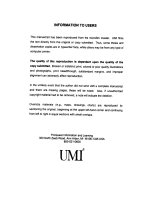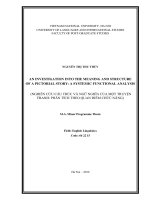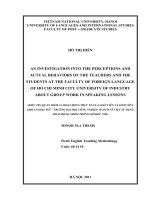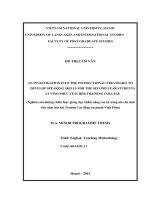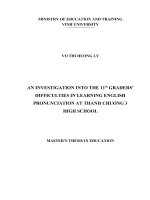AN EMPIRICAL INVESTIGATION INTO THE FACTORS CRITICAL TO THE EFFECTIVENESS OF ABS IMPLEMENTATION AT THE NATIONAL AND INTERNATIONAL LEVELS
Bạn đang xem bản rút gọn của tài liệu. Xem và tải ngay bản đầy đủ của tài liệu tại đây (3.36 MB, 363 trang )
Institut für Lebensmittel- und Ressourcenökonomik der Rheinischen Friedrich-WilhelmsUniversität zu Bonn
AN EMPIRICAL INVESTIGATION INTO THE FACTORS CRITICAL TO THE
EFFECTIVENESS OF ABS IMPLEMENTATION AT THE NATIONAL AND
INTERNATIONAL LEVELS
Inaugural-Dissertation
zur
Erlangung des Grades
Doktor der Agrarwissenschaften
(Dr.Agr.)
der
Landwirtschaftlichen Fakultät
der
Rheinische Friedrich-Wilhelms–Universität
zu Bonn
vorgelegt am 26.11.2014
Sem T. Shikongo
aus
Luderitz, Namibia
Supervisor:
Prof Dr. Karin Holm-Müller
Co-Supervisor:
Prof Dr. Thomas Heckerlei
Tag der Mündlichen Prüfung:
12.06.2015
Erscheinungsjahr:
2015
ZUSAMMENFASSUNG
Die vorliegende wissenschaftliche Arbeit untersucht kritische Faktoren zur Abschätzung der
Effektivität der existierenden Instrumente Zugang und Vorteilsausgleich (im Folgenden ABS,
Access and Benefit Sharing nach Art. 15 der Convention on Biodiversity) auf nationaler und
internationaler Ebene hinsichtlich der effektiven Umsetzung der damit verbundenen Ziele.
Mit Hilfe der New Institutional Economics (NIE) wurden eine Reihe geeigneter Indikatoren für
die o. a. Faktoren identifiziert. Eine globale schriftliche Befragung bei den Beteiligten am
internationalen ABS-Prozess zu den Umsetzungsbedingungen der ABS- Instrumente
bestätigte die Wichtigkeit and Gültigkeit der theoretisch abgeleiteten Faktoren und Indikatoren.
Es wurde zudem bestätigt, dass die nationale Position zur ABS Politik sowie deren Umsetzung
reagiert auf dynamische interne und externe Faktoren, z.B. politischen Druck, sich ändernde
Nachfragesituation, neue Konkurrenten, neue Forschungsergebnisse, technologische
Innovationen, Kritik von NGOs, dem Privatsektor, von Medien und Regierungen sowie
Änderungen der gesetzlichen Rahmenbedingungen.
Die Arbeit geht auch auf die Frage ein, inwieweit institutionelles Lernen während der
Verhandlungen zum Nagoya Protokoll über ABS beobachtet werden konnten. Es konnte
gezeigt werden, dass verschiedene innovative Prozesse genutzt wurden, um Blockaden im
Verhand-lungsprozess zu überwinden, so dass man in der Tat von einem signifikanten
Lernprozess während der Verhandlungen zum Nagoya Protokoll sprechen kann. Eine
Herausforderung wird sein, dieses Lernen zu institutionalisieren, damit es die Implementierung
von ABS informieren kann. Aus den Ergebnissen der Arbeit wird die Empfehlung abgeleitet,
einen polyzentrischen Ansatz für die ABS-Implementierung zu wählen, der sich auf die
Erfahrungen des institutionellen Lernens gründet. Dieser Ansatz betont, dass die
Implementierung des Protokolls nur dann erfolgreich sein kann, wenn die Privatwirtschaft
sowie indigene und lokale Gemeinschaften in den Prozess eingebunden werden.
Die Namibische Fallstudie zeigt die Nützlichkeit der identifizierten kritischen Faktoren und
Indikatoren für die Beurteilung von ABS Implementierung. Für Namibia wurde diese
Entwicklung als klar positiv eingeschätzt. Die Ergebnisse der Fallstudie können zur Gestaltung
einer angemessenen ABS-Politik sowie zur Optimierung ihrer Durchführung beitragen.
III
ABSTRACT
The research presented in this thesis firstly investigates critical factors for assessing the
effectiveness of existing Access and Benefit Sharing (ABS) instruments at the national and
international levels with respect to the effective implementation of the associated goals in line
with Article 15 of the CBD. The analysis and identification of indicators for the critical factors
took place within the theoretical framework of New Institutional Economics (NIE).
A global stakeholder survey on the necessary conditions for effective ABS instruments
implementation confirmed the importance and validity of the theoretically derived critical factors
and their indicators. Besides, it was confirmed that national ABS policy and implementation
respond to dynamic internal and external factors like political pressure, changing market
demand, new competitors, new scientific findings, technology innovations, criticism from
NGOs, industry, media, governments as well as legal changes.
The study also looked at the question as to whether institutional learning was observed during
the negotiation of the Nagoya Protocol. This was confirmed given that different innovative
processes were used to transcend some of the blockages that blocked fluidity in negotiations
and one can thus indeed speak of a significant learning process during the negotiations of the
Nagoya Protocol. Based on the insights from the findings, a polycentric approach to ABS
implementation is suggested, importantly involving both the private sector and indigenous and
local communities if success is to be achieved.
A case study in Namibia showed that the identified critical factors and their indicators are
indeed useful tools for assessing ABS implementation. It showed a clear progression over time
in how the Namibian government had been dealing with ABS. This assessment of the
effectiveness of Namibia’s approach to ABS implementation provides useful insights and
lessons that could lead to improvements in ABS policy and implementation.
IV
ACKNOWLEDGEMENTS
My sincere thanks and gratitude goes to Professor Karin Holm-Müller for her guidance,
constructive criticism, encouragement and infectious enthusiasm and friendship that she
granted me throughout the entire five years of the research and writing of this study.
I am also greatly indebted to the staff, colleagues, fellow students and friends at the ILR over
the years, notably, Prof Dr. Thomas Heckerlei, Carmen, Sabine, and Daniel, as well as all the
other colleagues, who shared a word of advice and encouragement or simply comradeship.
Their enthusiasm, and positive attitude inspired me during the long office sessions in cold
Germany.
Gratitude and appreciation goes to all those who showed me the way - my teachers, guardians
and mentors - from childhood and onwards towards the light.
My sincere gratitude to all my ABS colleagues all over the world who made this research
possible. They dutifully completed a long and harrowing questionnaire in support of one of their
long-standing comrades. I am grateful to all of you.
Many thanks to my friends and colleagues, especially Prof Dr. Mary Seeley, Dr. Kwaambwa,
Dr. Juliane Zeidler, Linda Scott and Dr. Leena Daniel for their patience and guidance and
support, especially in the final stages of the work and write up process, as well as for
encouraging me to finish.
A special thanks to my friend Dr. Nortin Titus for his comradeship and encouragement
throughout this long walk and my friend Heinrich Appies.
Many thanks to my colleagues at the Directorate of Tourism in the Ministry of Environment and
Tourism and the other Ministry Staff for their support and continuous encouragement.
I am indebted to my good friends and fellow ABS Warriors who stood beside me through all
this time in particular, Mr. Pierre du Plessis, Olivier Rukondo, Leontine Crisson, Kabir Bavikate,
Cyril Lombard, Andreas Drews, Konrad, Uebelhoer, Suhel Al Janabi and his family, Toivo
Uahengo. I salute you all.
I would like finally to express my gratitude to my entire family especially my mum Frieda N
Shikongo, my daughter (Nelago), Aino Shipuata, Elia, Kabi, Leonard, Uncle Vatie, Imke,
cousins, uncles, aunties and all my friends for their support over the years, their guidance, their
V
understanding and for allowing me to be gone from home for long periods especially over
festive seasons to be in Germany and for believing in me.
I dedicate this work to one who inspired me, gave me the way and showed me that there is
always a way, this too shall pass, my name sake Dr. Shafishuna Nujoma, Founding Father of
the Republic of Namibia.
It is further dedicated to my friends who have gone over the great divide and who I know stood
with me through many hardships: My father Jonas Haufiku, the late Mr. Peter Kirsten, Mr. Job
Plaaitjies, Mr. Johannes Amuthenu, Mr. Enock Boet Jantje, Herman Weitzel, Vidette
Shanyengange, Zelda Strauss and all my elders and teachers who are on the other side.
VI
Table of Contents
ZUSAMMENFASSUNG ...................................................................................................... 3
ABSTRACT ........................................................................................................................ 4
ACKNOWLEDGEMENTS ................................................................................................... 5
LIST OF TABLES ............................................................................................................. 18
LIST OF FIGURES ........................................................................................................... 21
APPENDIX ....................................................................................................................... 22
LIST OF ABBREVIATIONS .............................................................................................. 23
CHAPTER 1 ......................................................................................................................... 26
BACKGROUND OF THE STUDY ......................................................................................... 26
1.1 INTRODUCTION ........................................................................................................ 26
1.2 ABS & THE STATE OF THE CRITICAL FACTORS.................................................... 28
1.2.1 Snapshot of ABS and the Issues Around it .......................................................... 28
1.2.2 Overview of the Critical Factors for Assessing the Effectiveness of ABS ............. 32
1.2.3 Assumptions about the Critical Factors ................................................................ 34
1.3. RATIONALE FOR THE STUDY ................................................................................. 35
1.4 OBJECTIVES OF THE STUDY .................................................................................. 35
1.4.1 Strategic Objective 1 ............................................................................................ 35
1.4.2. Strategic Objective 2 ........................................................................................... 35
1.4.3 Strategic Objective 3 ............................................................................................ 36
1.4.4 Strategic Objective 4 ............................................................................................ 37
1.4.5 Strategic Objective 5 ............................................................................................ 37
1.4.6 Strategic Objective 6 ............................................................................................ 38
1.5 METHODOLOGICAL APPROACH ............................................................................. 38
1.6 CONTRIBUTION AND OUTLOOK.............................................................................. 38
1.7 STUDY OVERVIEW ................................................................................................... 39
1.7.1 Research Approach and Structure of the Thesis .................................................. 39
CHAPTER 2 ......................................................................................................................... 42
THEORETICAL FRAMEWORK OF THE STUDY ................................................................. 42
VII
2.1 INTRODUCTION ........................................................................................................ 42
2.2 THE RELEVANCE OF NIE FOR ABS......................................................................... 44
2.2.1 Property Rights Theory ........................................................................................ 45
2.2.2 Principal Agent Theory (Formal Contract Theory) ................................................ 46
2.2.3 Transaction Costs Economics .............................................................................. 51
2.2.4 Social Capital and its Relevance to ABS .............................................................. 54
2.2.5 Effectiveness and Efficiency of ABS Instruments from an NIE Perspective .......... 55
2.2.6 Efficiency and its Relevance to ABS .................................................................... 56
2.2.7 Legitimacy and ABS............................................................................................. 57
2.2.8 Legitimizing Authority at the level of Governance ................................................. 57
2.2.9 Legitimizing Coercive Power at the Level of Institutional Environment ................. 58
CHAPTER 3 ......................................................................................................................... 60
LITERATURE REVIEW: BIOPROSPECTING THE ISSUES ................................................ 60
3.1 INTRODUCTION ........................................................................................................ 60
3.2 BIOPROSPECTOR DEFINED .................................................................................... 61
3.3 INTERNATIONAL RESPONSE TO REGULATE ABS: THE CBD AND THE
NAGOYA PROTOCOL ON ABS ....................................................................................... 62
3.4 THE MARKET FOR BIOPROSPECTING ................................................................... 63
3.5 THE LINK BETWEEN BIOTECHNOLOGY AND BIOPROSPECTING ........................ 67
3.6 THE NAGOYA PROTOCOL ON ACCESS AND BENEFIT-SHARING AND ITS
LINK TO BIOPROSPECTING........................................................................................... 68
3.6.1 The Core Elements of the Nagoya Protocol ......................................................... 70
3.6.2 Access ................................................................................................................. 70
3.6.3 Fair and Equitable Sharing of Benefits ................................................................. 71
3.6.4 Compliance .......................................................................................................... 71
3.6.5 Provisions Related to TK and to Indigenous and Local Communities ................... 71
3.6.6 Tools and Mechanism to Assist with Implementation ........................................... 71
CHAPTER 4 ......................................................................................................................... 73
DEVELOPMENT
OF
INDICATORS
TO
MEASURE
EFFECTIVE
ABS
IMPLEMENTATION AT THE NATIONAL AND INTERNATIONAL LEVELS ......................... 73
VIII
4.1 INTRODUCTION ........................................................................................................ 73
4.1.1 Indicators and the Issues around them ................................................................ 73
4.2 LITERATURE REVIEW ON THE EFFECTIVENESS OF ABS REGIME WITH A
VIEW TO DERIVE INDICATORS ..................................................................................... 75
4.2.1 Case Studies of Review of Implementation of ABS Instruments Around the
World ............................................................................................................................ 78
4.2.1.1 The Kenyan Case ............................................................................................. 79
4.2.1.2 The Australian Case ......................................................................................... 80
4.2.1.3 The South African Case .................................................................................... 82
4.3 EFFECTIVE IMPLEMENTATION OF THE NAGOYA PROTOCOL ............................. 84
4.3.1 Need for Legal Clarity, Transparency and Certainty ............................................. 88
4.3.1.1 Use of the Definition of Genetic Resource as provided for by the Protocol ........ 89
4.3.1.2 Use of the Definition of the Concept of Utilization of Genetic Resources ........... 89
4.3.1.3 Supporting ABS Complying Users to Minimize the Challenge of NonCompliance................................................................................................................... 89
4.3.1.4 Measures for Dealing with Benefits Arising ....................................................... 90
4.3.1.5 The Use of Primary Legal Vehicles of Access to Genetic Resources ................ 90
4.3.1.6 Assurance of Contractual Certainty ................................................................... 91
4.3.1.7 Industry Standards ............................................................................................ 91
4.3.1.8 Clear Basic Commercial and Administrative Rights on the Provider Side .......... 91
4.3.1.9 Compliance Measures ...................................................................................... 92
4.3.1.10 The Use of Model and Default Clauses ........................................................... 93
4.3.1.11 Incentive Measures in both Provider and User Countries ................................ 93
4.3.1.12 Measures to Ensure Equity and Equality ......................................................... 93
4.3.1.13 User-Side Approaches .................................................................................... 93
4.3.1.14 Provider Side Approaches .............................................................................. 94
4.3.1.15 Informational Mechanisms .............................................................................. 94
4.3.1.16 Use of an ABS Clearing House Mechanism (CHM) ......................................... 94
4.3.1.17 National Decision-Making Procedures ............................................................ 95
4.3.1.18 Information on Evidentiary Rules .................................................................... 95
IX
4.3.1.19 ABS Ombudsman ........................................................................................... 95
4.3.1.20 Communication Processes and Strategies and Disclosure Requirements....... 95
4.3.1.21 Enabling Bilateral Action ................................................................................. 95
4.4 CONCLUSION............................................................................................................ 96
CHAPTER 5 ......................................................................................................................... 98
METHODOLOGY ................................................................................................................. 98
5.1 INTRODUCTION ........................................................................................................ 98
5.2 GLOBAL AND NAMIBIA EXPERT INTERVIEWS ....................................................... 98
5.3 GLOBAL ON-LINE SURVEY ...................................................................................... 99
5.4 INSTITUTIONAL LEARNING: THE CASE OF THE ABS NEGOTIATIONS WITHIN
THE CONVENTION ON BIOLOGICAL DIVERSITY ....................................................... 101
5.5 DATA ANALYSIS ..................................................................................................... 101
5.5.1 The Chi Square Test .......................................................................................... 101
5.5.2 Fischer’s Exact Test........................................................................................... 102
5.5.3 Measure of Association ...................................................................................... 102
5.6 FACTOR ANALYSIS ................................................................................................ 104
5.6.1 Test to Determine Whether Factor Analysis Can Be Undertaken On the Data ... 105
5.6.1.1 Kaiser-Meyer-Olkin (KMO) Measure of Sampling Adequacy ........................... 105
5.6.2 Bartlett’s Test of Sphericity ................................................................................ 105
5.6.3 The Steps Involved in Performing Exploratory Analyses .................................... 105
5.6.3.1 Assumption Testing for Factor Analysis .......................................................... 105
5.6.3.2 Type of Factor Analysis: Principal Component Analysis .................................. 106
5.6.3.3 Number of Factors & Items Removed ............................................................. 106
5.6.3.4 Rotation Method ............................................................................................. 106
5.6.3.5 Factor Loadings .............................................................................................. 106
5.6.3.6. Label Factors ................................................................................................. 106
5.7 NAMIBIA AS A CASE STUDY .................................................................................. 107
5.8 ORGANISATIONAL/INSTITUTIONAL LEARNING: THE CASE OF THE CBD AND
THE NEGOTIATION OF THE NAGOYA PROTOCOL .................................................... 107
X
CHAPTER 6 ....................................................................................................................... 108
RESULTS AND DISCUSSION OF THE ONLINE SURVEY ON ABS ................................. 108
6.1 INTRODUCTION ...................................................................................................... 108
6.2 CRITICAL FACTORS DERIVED FOR THE STUDY ................................................. 108
6.2.1 List of Critical Factors ........................................................................................ 108
6.3 THE ONLINE ABS SURVEY - RESULTS ................................................................. 109
6.3.1 Demographics.................................................................................................... 109
6.3.2 The Definition of the Effectiveness of Domestic ABS Administrative, Policy
and Legal Framework ................................................................................................. 110
6.3.3 The Types of User Firms Involved in the ABS market ........................................ 111
6.4 RESULTS AND DISCUSSIONS FOR THE FACTOR ANALYSIS ............................. 111
6.4.1 Theoretical Underpinning for Factor Analysis on ABS ........................................ 111
6.4.2 Assumption Testing for Factor Analysis ............................................................. 112
6.4.3 Type of Factor Analysis: Principal Component Analysis ..................................... 112
6.4.4 Number of Factors and Items Removed............................................................. 113
6.4.5 Rotation Method ................................................................................................ 114
6.4.6 Factor Loadings ................................................................................................. 114
6.4.7 Labeling of Factors Derived ............................................................................... 115
6.5 THE INDICATORS DERIVED FOR THE CRITICAL FACTORS ............................... 115
6.5.1 Indicators for Good Governance Structure as a Critical Factor .......................... 115
6.5.2 Indicators for the Assignment of Intellectual Property Rights as a Critical
Factor ......................................................................................................................... 118
6.5.3 Indicators for Non-Complex Administrative Structure as a Critical Factor ........... 121
6.5.4 Indicators for Time Lags to Benefits as a Critical Factor .................................... 125
6.5.5 Indicators for Information Assymetry as a Critical Factor.................................... 128
6.5.6 Indicators for the Efficient Understanding of the ABS Market Structure as a
Critical Factor ............................................................................................................. 132
6.5.7 indicators for Valorisation of Biodiversity as a Critical Factor ............................. 138
6.5.8 Indicators for Measures to Build (Trust) Social Capital as a Critical Factor ........ 142
XI
6.6 CONFIRMATION OF WHETHER THE CRITICAL FACTORS ARE IMPORTANT
FOR THE EFFECTIVE IMPLEMENTATION OF THE NAGOYA PROTOCOL AT THE
NATIONAL LEVEL OR NOT ........................................................................................... 147
6.7 CONFIRMATION OF THE IMPORTANCE OF CRITICAL FACTORS AT
NATIONAL AND INTERNATIONAL LEVELS ................................................................. 149
6.8 INTERNAL AND EXTERNAL FACTORS THAT COULD IMPACT OR INFLUENCE
THE CRITICAL FACTORS ............................................................................................. 150
6.9 OVERALL DISCUSSION .......................................................................................... 152
6.10 CONCLUSIONS ..................................................................................................... 156
6.11 RECOMMENDATIONS .......................................................................................... 156
CHAPTER 7 ....................................................................................................................... 157
INSTITUTIONAL LEARNING: THE CASE OF THE ABS NEGOTIATIONS ........................ 157
WITHIN THE CBD LESSONS TOWARDS EFFECTIVE IMPLEMENTATION OF THE
NAGOYA PROTOCOL ON ABS AND DOMESTIC ABS INSTRUMENTS .......................... 157
7.1 INTRODUCTION AND BACKGROUND ................................................................... 157
7.2 OVERVIEW OF THE ISSUES AROUND ORGANIZATIONAL LEARNING BASED
ON THE LITERATURE REVIEW .................................................................................... 159
7.2.1 The Institutional Environment and Institutional Arrangements and their
Relevance to Institutional Learning ............................................................................. 160
7.2.2 How Does Institutional Change Occur?.............................................................. 163
7.2.3 Issues Facing Empirical Research on Organizational Learning Process ............ 165
7.2.4 Institutional Learning as Change in the Behavior of Individual Resulting in
Changed Institutional Arrangements ........................................................................... 167
7.2.5 Communication Structures in the ABS Policy Arena .......................................... 170
7.2.6 Reflexive Mechanisms ....................................................................................... 172
7.2.7 Values, Norms and Conflicts .............................................................................. 172
7.3 EXTERNAL INFLUENCES ....................................................................................... 173
7.4 DISCUSSION ........................................................................................................... 174
7.4.1 Institutional Mechanisms to Facilitate Cooperative Outcomes in ABS
Implementation ........................................................................................................... 176
XII
7.4.2 Non-Continuity of Key Negotiators and Characteristics of the Key Negotiators
................................................................................................................................... 179
7.4.3 Use of Language and Ways of Communicating ................................................. 179
7.4.4 Blocking of Movement in One Forum to Await Perceived Progress in Another ... 180
7.4.5 Innovation and Adaptive Management of the Negotiating Process for the
Nagoya Protocol ......................................................................................................... 180
7.4.6 A New Way of Interaction for ABS Implementation ............................................ 188
7.5 CONCLUSION AND RECOMMENDATION .............................................................. 191
CHAPTER 8 ....................................................................................................................... 193
AN ASSESSMENT OF NAMIBIA AS A CASE STUDY, AND ITS UTILISATION OF THE
CRITICAL FACTORS IN RELATION TO ABS .................................................................... 193
8.1 INTRODUCTION ...................................................................................................... 193
8.2 OBJECTIVE OF THE STUDY ................................................................................... 194
8.2.1 Specific Objective 1 ........................................................................................... 194
8.2.2 Specific Objective 2 ........................................................................................... 194
8.3 LITERATURE REVIEW - THE EVOLUTION OF ABS IN NAMIBIA ........................... 194
8.3.1 ABS in Context - Key Concepts of ABS in the Namibian Context ....................... 194
8.3.2 The Namibian Response to ABS........................................................................ 196
8.3.3 The Namibian National Biodiversity Strategy and Action Plan and ABS
Implementation ........................................................................................................... 197
8.3.4 Development of Namibia’s ABS Legal Framework ............................................. 201
8.3.5 Emergence of a National Approach towards ABS .............................................. 203
8.3.6 Assessing the Effectiveness of Namibia’s ABS Legal Framework ...................... 206
8.4 METHODOLOGY ..................................................................................................... 209
8.4.1 Introduction ........................................................................................................ 209
8.4.2 Literature review ................................................................................................ 209
8.4.3 Interviews .......................................................................................................... 209
8.4.4 Structure and Approach Used For the Exploration of the Critical Factors ........... 210
8.5 RESULTS ................................................................................................................. 214
8.5.1 Introduction ........................................................................................................ 214
XIII
8.5.2 Results for Phase 1............................................................................................ 215
8.5.3 Results for Phase 2 (1995 – 2000)..................................................................... 220
8.5.4 Results For Phase 3 (2000 – 2005) ................................................................... 224
8.5.5 Results for Phase 4 (2005 -2012) ...................................................................... 227
8.6 DISCUSSION ........................................................................................................... 231
8.6.1 DISCUSSION OF RESULTS ON THE OVERALL RESPONSES BY THE
VARIOUS STAKEHOLDER CATEGORIES ................................................................ 231
8.6.1.1 Research and Academia Stakeholders ........................................................... 231
8.6.1.2 Government Stakeholders .............................................................................. 232
8.6.1.3 Local Communities Stakeholders .................................................................... 233
8.6.1.4 Civil Society Stakeholders............................................................................... 233
8.6.1.5 Private Sector Stakeholders ............................................................................ 235
8.7 KEY ISSUES THAT AROSE FOR EACH OF THE CRITICAL FACTORS IN
TERMS OF ABS IMPLEMENTATION IN NAMIBIA DURING THE DIFFERENT
PHASES ..................................................................................................................... 236
8.7.1 Phase 1:The Beginning Of The Abs Policy Dialogue In Namibia (1990 -1995)... 236
8.7.1.1 Good Governance Structure in both Provider and User Countries .................. 236
8.7.1.2 Discussion on the Indicators Derived for this Critical Factor: ........................... 237
8.7.1.3 Assigning Property Rights and Intellectual Property Rights ............................. 238
8.7.1.4 Discussion on the Indicators Derived for this Critical Factor ............................ 239
8.7.1.5 Summarizing Remarks for Phase 1 ................................................................. 240
8.7.2 Phase 2: Experience On ABS Five Years After Independence And The
Beginning Of The ABS Dialogue Proper (1995 -2000) ................................................ 241
8.7.2.1 Effective, Functional and Non-Complex Administrative Structure/Framework
is in Place ................................................................................................................... 241
8.7.2.2 Institutional Efficiency and Administrative Efficiency ....................................... 243
8.7.2.3 Discussion of Indicators Derived for this Critical Factor ................................... 244
8.7.2.4 Addressing or Accounting for Time Lags to the Generation and Sharing of
Benefits ...................................................................................................................... 245
8.7.2.5 Discussion of the Indicators Derived for this Critical Factor ............................. 246
XIV
8.7.2.6 Summarizing Remarks for Phase 2 ................................................................. 247
8.7.3 Phase 3: Informed Decisions On ABS And Its Marked 15 Years After
Independence ............................................................................................................. 248
8.7.3.1 Efficient Understanding of The ABS Market Structure within which the
Transaction Must Take Place ..................................................................................... 248
8.7.3.2 Discussion of the Indicators Derived for this Critical Factor ............................. 250
8.7.3.3 Presence of an Effective and Functional Biodiversity Valorization Strategy
at National Level ......................................................................................................... 251
8.7.3.4 Discussion of the Indicators Derived for this Critical Factor ............................. 252
8.7.3.5 Summarizing Remarks for Phase 3 ................................................................. 253
8.7.4 Phase 4: Current State Of Affairs With ABS (2005 – 2012) ................................ 253
8.7.4.1 Effective Measures to Address Information Asymmetry in the ABS
Implementation Framework ........................................................................................ 253
8.7.4.2 Discussion on the Indicators Derived for this Critical Factor ............................ 254
8.7.4.3 Presence of Effective and Efficient Measures to Build Trust (Social Capital)
Amongst Stakeholders ................................................................................................ 255
8.7.4.4 Discussion on the Indicators Derived for this Critical Factor ............................ 256
8.7.4.5 Summarizing Remarks for Phase 4 ................................................................. 256
8.7.5 The Internal and External Factors That Impact On The Critical Factors As
Derived From The Global Survey On ABS. ................................................................. 258
8.7.5.1 Criticism from Different Interest and Advocacy Groups and Change in Legal
Framework.................................................................................................................. 258
8.7.5.2 Advancement in Science and Technology As Well As Special
Circumstances at the National Level ........................................................................... 259
8.7.6 Overall Discussion for The Discussion Session ................................................. 259
8.7.7 Has Namibia’s Approach to ABS Implementation Been Successful? ................. 261
8.7.7.1 Cases of ABS and Biotrade in Namibia over the Years ................................... 261
8.7.7.2 Analysis of Material Transfer Agreements signed in Namibia Between 2008
- 2012 ......................................................................................................................... 264
8.8 CONCLUSIONS ................................................................................................... 267
XV
CHAPTER 9 ....................................................................................................................... 269
OVERALL CONCLUSIONS AND POLICY IMPLICATIONS................................................ 269
9.1 INTRODUCTION ...................................................................................................... 269
9.2 SYNTHESIS OF EMPIRICAL FINDINGS AND ANSWERS TO RESEARCH
QUESTIONS .................................................................................................................. 270
9.3 LIMITATIONS OF THE STUDY ................................................................................ 273
9.4 THEORETICAL AND POLICY IMPLICATIONS ........................................................ 276
9.5 OUTLOOK FOR FURTHER RESEARCH ................................................................. 276
REFERENCES ................................................................................................................... 278
Appendix 1 Questionnaire For The Global Survey On ABS ................................................ 295
Appendix 2 Factor Analysis Results For Good Governance Structure In Both Provider
And User Countries ............................................................................................................ 322
Appendix 3 Factor Analysis Results Assigning Propoerty Rights And Intellectual Property
Rights ................................................................................................................................. 324
Appendix 4 Factor Analysis Results Effective, Functional And Non-Complex
Administrative Structure/Framework Is In Place ................................................................. 326
Appendix 5 Factor Analysis Results Addressing Or Accounting For Time Lags To The
Generation And Sharing Of Benefits................................................................................... 331
Appendix 6 Factor Analysis Results Efficient Understanding Of The ABS Market
Structure Within Which The Transaction Must Take Place ................................................. 334
Appendix 7 Factor Analysis Results Presence Of An Effective And Functional
Biodiveristy Valorization Strategy At National Level ............................................................ 337
Appendix 8 Factor Analyais Results Effective Measures To Address Information
Asymmetry In The ABS Implementation Framework Are In Place ...................................... 340
Appendix 9 Factor Analysis Results Presence Of Effective And Efficient Measures To
Build Trust (Social Capital) Amongst Stakeholders ............................................................. 343
Appendix 10 Factor Analysis Results For An Effective And Functional Biodiveristy
Valorization Strategy At National Level ............................................................................... 346
Appendix 11 Factor Analysis Results For The National And International Levels
Indicating Whether Crticial Factors Are Valid ...................................................................... 349
Appendix 12 Factor Analsys Results Of Internal And External Factors That May Impact
On ABS Implementation ..................................................................................................... 353
XVI
Appendix 13 Questionnaire for the Namibian Case Study on ABS ..................................... 357
Appendix 13 ABS Excerpts From The Namibian National Biodiversity Strategy And
Action Plan (NBSAP) .......................................................................................................... 362
XVII
LIST OF TABLES
Table 2.1:
Property Rights Theory and its relevance to ABS
Table 2.2:
Principal Agent Theory (Formal Contract Theory) and its relevance to ABS
Table 2.3:
Transaction costs economics and its relevance to ABS
Table 2.4:
Forms of transaction costs according to basic literature, supplemented with
findings from access and benefit- research
Table 2.5:
Summary of effectiveness from an NIE perspective
Table 3.1:
Potential synergies between biotechnology development and value added
bioprospecting
Table 3.2:
Chronological emergence of multilateral agreements on genetic resources
and/or the associated (traditional) knowledge relevant to the ABS process and
the Nagoya Protocol on ABS
Table 4.6:
Use of legal tools
Table 5.1:
Technical details of the face-to-face expert interviews that preceded the online
survey
Table 5.2:
Technical details of the online ABS global survey
Table 5.3:
Type of data calculated by Kendall’s tau-b
Table 5.4:
Type of data calculated by Kendal tau-c
Table 5.5:
The technical details of the online ABS global survey
Table 5.6:
The statistical measures applied in the evaluation of the online survey
Table 6.1:
The Demographics of the online Survey
Table 6.2:
Definition of the effectiveness of ABS as Determined by the ABS Players
Table 6.3:
The Type of User Firms involved the ABS Sector
Table 6.4:
Results of the KMO, Bartlett’s Tests and Cumulative Variance of the Factor
Analysis
Table 6.5:
Dimension Reduction of Indicators for the Critical Factors
Table 6.6:
Indicators for good governance structure in both provider and user countries
Table 6.7:
Indicators for the assignment of property and intellectual property rights
Table 6.8:
Indicators for effective, functional and non-complex administrative structures
Table 6.9:
Indicators for measures to address time lags to the generation of benefits
Table 6.10:
Indicators for measures to address information asymmetry
Table 6.11:
The various stakeholders who participated in the ABS Negotiations and their
respective interests
Table 6.12
Indicators for efficient understanding of the ABS market structure
XVIII
Table 6.13
Indicators for measures to address valorization of biodiversity in provider
countries
Table 6.14
Indicators for measures to build trust amongst stakeholders in the ABS game
Table 6.15
Importance of critical factors at the national and international level
Table 6.16
Internal and external factors that may impact on the critical factors
Table 7.1
The Methods of innovation used that can be regarded as contributing to
institutional learning towards more efficient negotiations under the CBD
Table 8.1:
Chronological depiction of Namibia’s involvement in the ABS debate
Table 8.2:
Categorization and description of stakeholders that took part in the studyTable
8.3:
Summary of the time frames, groupings of the critical factors per time
frame and rationale for the approach
Table 8.4:
Results for Phase 1
Table 8.5:
Results for Phase 2
Table 8.6:
Results for Phase 3
Table 8.7:
Results for Phase 4
Table 8.8:
Assessment of good governance structure in both provider-and user-countries
based on derived indicators
Table 8.9:
Assessment of assigning property rights and intellectual property rights based
on derived indicators
Table 8.10:
Assessment of administrative structure/framework based on derived indicators
Table 8.11:
Assessment of accounting for time lags to the generation and sharing of
benefits based on derived indicators
Table 8.12:
Assessment of efficient understanding of the ABS market structure within which
the transactions occur based on the indicators derived.
Table 8.13:
Assessment of an effective and functional biodiversity valorization strategy at
the national level based on the indicators derived
Table 8.14
Assessment of effective measures to address information asymmetry in the
ABS implementation framework based on the indicators derived for this critical
factor
Table 8.15:
Assessment of effective and efficient measures to build trust (social capital)
amongst stakeholders bases on the critical factors
Table 8.16:
Summary of research and collection permits issued in Namibia between 1999
and 2007
Table 8.17:
Main countries to which permits have been issued by Namibia
Table 8.18:
Cases of genetic resources that have been of interest and that have been
processed in Namibia
XIX
Table 8.19:
Analysis of Material Transfer Agreements in Namibia over a period of five years
(2012 – 2008)
XX
LIST OF FIGURES
Figure 5.1
The model for Principal Component Analysis
Figure 5.2
The Factor Analysis Process
Figure 8.1
The Namibian Pipeline Approach
XXI
APPENDIX
Appendix 1:
Questionnaire for the global survey on ABS
Appendix.2:
Factor analysis results for good governance structure in both provider and
user countries
Appendix 3:
Factor analysis results assigning property rights and intellectual property
rights
Appendix 4:
Factor analysis results effective, functional and non-complex administrative
structure/framework is in place
Appendix 5:
Factor analysis results addressing or accounting for time lags to the
generation and sharing of benefits
Appendix 6:
Factor analysis results efficient understanding of the ABS market structure
within which the transaction must take place
Appendix 8:
Factor analysis results presence of an effective and functional biodiversity
valorization strategy at national level
Appendix 7:
Factor analysis results effective measures to address information
asymmetry in the ABS implementation framework are in place
Appendix 8:
Factor analysis results presence of effective and efficient measures to build
trust (social capital) amongst stakeholders
Appendix 9:
Factor analysis results for an effective and functional biodiversity
valorization strategy at national level
Appendix 10:
Factor analysis results for the national and international levels indicating
whether critical factors are valid
Appendix 11:
Factor analysis results of internal and external factors that may impacts on
ABS implementation
Appendix 12:
Questionnaire for the Namibian case study on ABS
Appendix 13:
ABS excerpts from the Namibian National Biodiversity Strategy and Action
Plan (NBSAP)
XXII
LIST OF ABBREVIATIONS
ABS - Access and Benefit- Sharing
ABS - CDI ABS Capacity Development Initiative
ABS CDI -ABS Capacity Development Initiative
AU - African Union
CBD - Convention on Biological Diversity
CBBT - Capacity Building for Biotrade Project
CBNRM - Community Based Natural Resource Management
CEPA - Capacity Building Education and Public Awareness
CHM -Clearing House Mechanism
CITES - Convention on the International Trade in Endangered Species
COs - Civic Organizations
CRIAA - Centre for Research Action Africa
CSIR - Council for Scientific and Industrial Research
DRFN - Desert Research Foundation of Namibia
DSS - Directorate of Scientific Services
EIF - Environmental Investment Fund
EU - European Union
GATT - General Agreement on Tariffs and Trade
GIZ - German Agency for Technical Cooperation
GR- Genetic Resource
GRID - Genetic Resources Information Data Base
IA - Institutional Arrangement
IBPC - Interim Bioprospecting Committee
ICEMA - Integrated Community Based Ecosystem Management Project
IE - Institutional Environment
INP - Indigenous Natural Product
IR - International Regime
IRC - Internationally Recognized Certificate
IPR - Intellectual Property Rights
IPTT - Indigenous Plant Task Team
ITPGRFA - International Treaty Plant Genetic Resources for Food and Agriculture
JHB - Johannesburg
LIC’s - Local and Indigenous Communities
MAT- Mutually Agreed Terms
MAWRD - Ministry of Agriculture Water and Rural Development
MET - Ministry of Environment and Tourism
XXIII
MEAs - Multilateral Environmental Agreements
MTAs - Material Transfer Agreements
NIE - New Institutional Economics
MOU - Memorandum of Understanding
NAC - National Competent Authority
NAD - Namibian Dollar
NBRI - National Botanical Research Institute
NBSAP - National Biodiversity Strategy and Action Plan
NDP - National Development Plan
NGO - Non Governmental Organization
NNBP - Namibian National Biodiversity Programme
OAU - Organization of African Unity
PIC - Prior Informed Consent
R&D - Research and Development
SA - South Africa
SBSTTA - Subsidiary Body on Science and Technological Advice
SADC - Southern African Development Community
TK - Traditional Knowledge
TRIPS - Trade Related Aspects of Industrial Property Rights
UN - United Nations
UNCCD - United Nations Convention to Combat Desertification
UNDP - United Nations Development Programme
UNEP - United Nations Development Programme
UNECE - United Nations Economic Commission for Europe
UNFCCC - United Nations Framework Convention on Climate Change
UPOV - Union for the Protection of Plant Varieties
USD - United States Dollar
XXIV
Do your utmost in trivial things
From that you can attain sincerity
This sincerity becomes apparent
From being manifest, it becomes brilliant
Being brilliant it affects others
Affecting others,
It changes them
Changing people, it transforms everything
It is only those with utmost sincereity
Who can transform everything
It will change
If you do your utmost, one by one,
The world will change.
The Classics: Asian Verse
25

